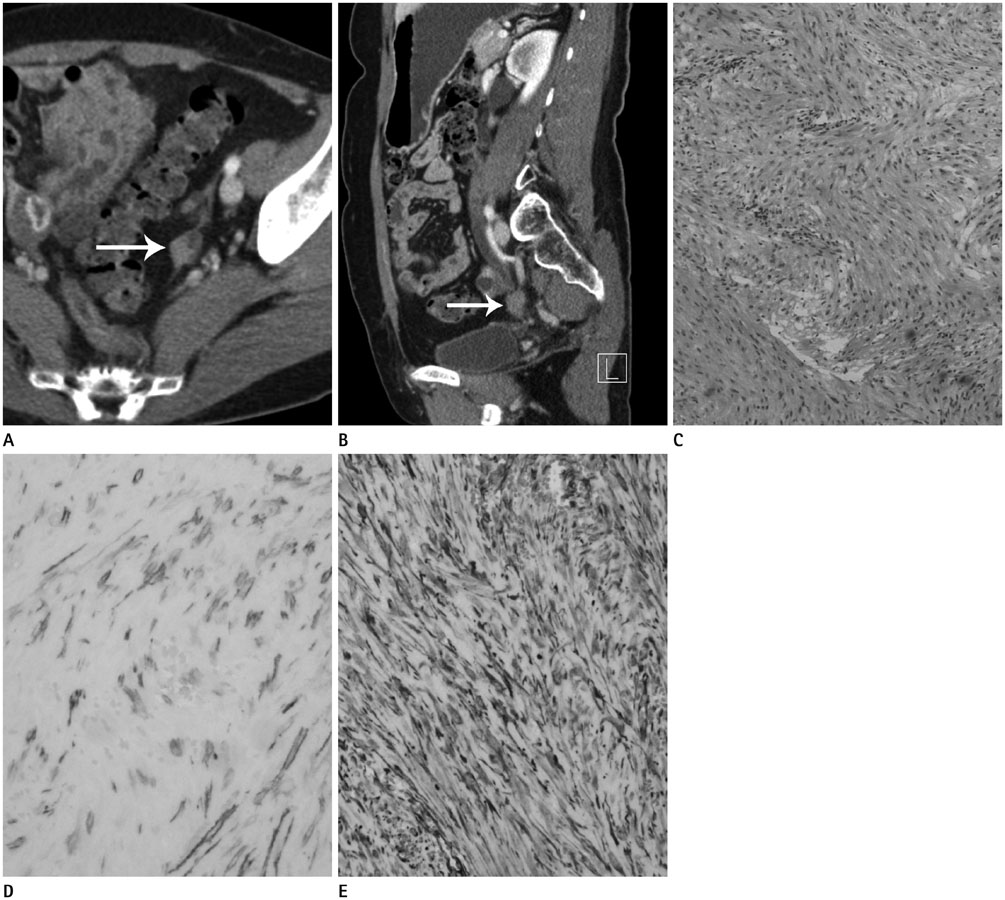J Korean Soc Radiol.
2014 Dec;71(6):320-323. 10.3348/jksr.2014.71.6.320.
Primary Leiomyoma of Ureter Coexisting with Renal Cell Carcinoma: A Case Report
- Affiliations
-
- 1Department of Radiology, Eulji University Hospital, Daejeon, Korea. orionphil@hotmail.com
- KMID: 1801556
- DOI: http://doi.org/10.3348/jksr.2014.71.6.320
Abstract
- Mesenchymal origin of ureter tumors account for less than 3 percent of all primary ureteral tumors. Among mesenchymal tumors, primary leiomyoma of ureter is extremely rare. Here, we present a case of primary leiomyoma of ureter coexisting with renal cell carcinoma. When encountering well-defined homogeneously enhanced mass of ureter on computed tomography, radiologist should keep in mind that ureteral leiomyoma should be considered as differential diagnosis.
Figure
Reference
-
1. Alvarado-Cabrero I, Candanedo-González F, Sosa-Romero A. Leiomyoma of the urethra in a Mexican woman: a rare neoplasm associated with the expression of estrogen receptors by immunohistochemistry. Arch Med Res. 2001; 32:88–90.2. Kurokawa S, Kojima Y, Tozawa K, Hayashi Y, Sasaki S, Kohri K. Female paraurethral leiomyoma: immunohistochemical approach to the relationship between leiomyoma and ovarian hormones. J Urol. 2002; 167:1403–1404.3. Mondschein LJ, Sutton AP, Rothfeld SH. Leiomyoma of the ureter in a child: the first reported case. J Urol. 1976; 116:516–518.4. Werth DD, Weigel JW, Mebust WK. Primary neoplasms of the ureter. J Urol. 1981; 125:628–631.5. Zehri AA, Ali A, Iqbal F, Jessca M. Primary leiomyoma--a rare tumour of ureter. J Pak Med Assoc. 2013; 63:268–270.6. Alam NA, Olpin S, Rowan A, Kelsell D, Leigh IM, Tomlinson IP, et al. Missense mutations in fumarate hydratase in multiple cutaneous and uterine leiomyomatosis and renal cell cancer. J Mol Diagn. 2005; 7:437–443.7. Nouralizadeh A, Tabibi A, Mahmoudnejad N, Taheri M, Torbati PM. Partial ureterectomy for a huge primary leiomyoma of the ureter. J Pak Med Assoc. 2010; 60:62–64.8. Casillas J, Joseph RC, Guerra JJ Jr. CT appearance of uterine leiomyomas. Radiographics. 1990; 10:999–1007.
- Full Text Links
- Actions
-
Cited
- CITED
-
- Close
- Share
- Similar articles
-
- Primary Squamous Cell Carcinoma of the Endometrium Covering Submucosal Leiomyoma
- Primary Squamous Cell Carcinoma of the Ureter after Reterocutaneoustomy
- Bilateral primary carcinoma of the ureter associated with acute renal failure
- Primary Squamous Cell Carcinoma of the Ureter
- A Case or Squamous Cell Carcinoma of the Renal Pelvis Associated with Squamous Cell Carcinoma in Situ of the Ureter



